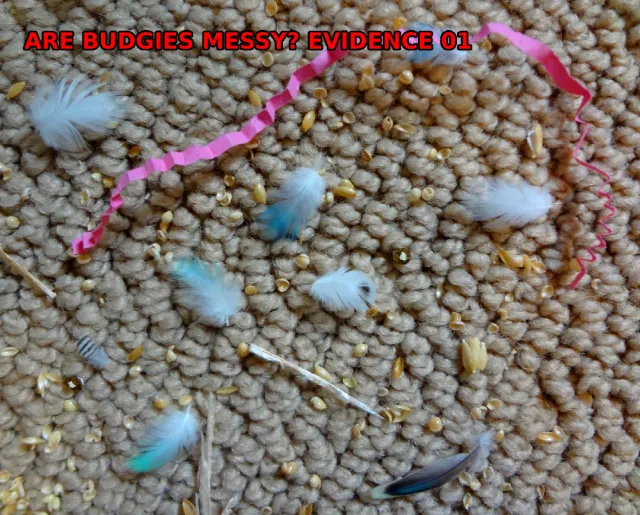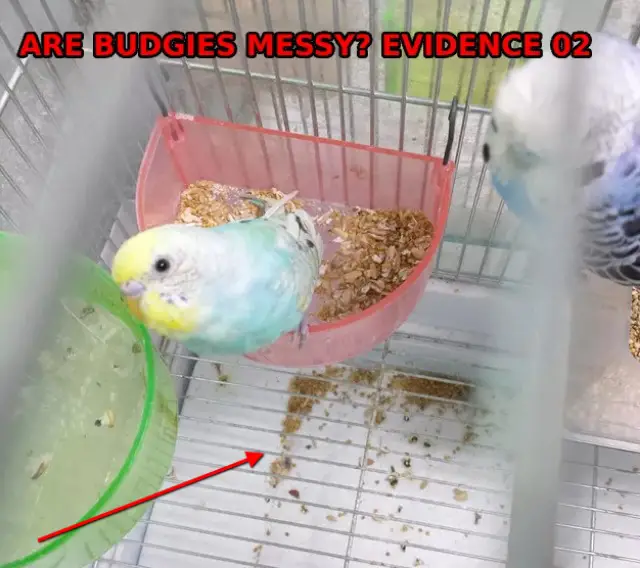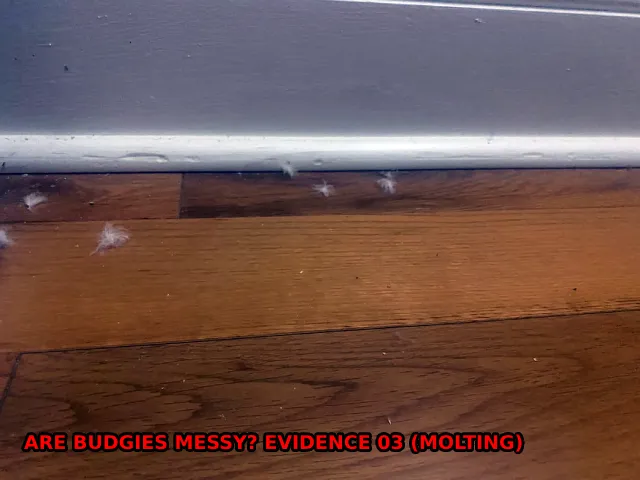Indeed, budgies can be considered messy due to their natural and instinctual behaviors.
This includes scattering food while eating, shredding toys or paper for entertainment, and creating cage waste.
However, these behaviors are all signs of a healthy, active budgie.
Budgies, just like other pets, can create a certain amount of mess in their surroundings.
From their natural waste to scattered food and feathers, to their playful shredding of paper and toys.
These small creatures do know how to keep their owners on toes when it comes to cleaning.
With my firsthand experience and insights from various resources, I planned and created this content that will be useful for anyone who is considering adding a budgie to their home, or those who already have one and are looking for ways to manage the mess.



Cage Waste
Among all the mess a budgie can create, the most common and noticeable one is the cage waste.
This consists mainly of their droppings but can also include discarded food and feathers.
Budgies, being small birds, naturally produce droppings throughout the day.
This can accumulate quickly in their cage, making it messy and potentially unhygienic.
Cleaning the cage becomes an essential routine for every budgie owner.
Budgie droppings are generally solid and do not have a strong odor, unlike cat or dog feces.
Yet, their consistency and color can change based on the bird’s diet, which can sometimes add to the mess.
For example, if your budgie eats a lot of fruits or vegetables, their droppings might be a bit more liquid, which could make the cage cleaning slightly more challenging.
Prevention
Now, how can one prevent or manage this inevitable cage waste? While it’s not possible to prevent a budgie from creating waste, certain measures can be taken to keep the mess under control and ensure the cage remains hygienic for your pet.
Regular cage cleaning is, of course, the most effective way to manage this mess.
It’s recommended to do a small clean up every day to remove droppings and any uneaten food.
A more thorough cleaning, including washing the cage and its accessories with pet-safe cleaners, should be done weekly.
Using bird cage liners or bedding can also help absorb waste and make cleaning easier.
These liners can be easily removed, replaced, and disposed of.
There are many types available in the market, like paper liners, sand, or cob bedding.
Remember, a clean cage is not just about aesthetics, but it’s also vital for the health and well-being of your budgie.
Regular cleaning can prevent the buildup of bacteria and keep your budgie happy and healthy.
Droppings
One cannot overlook the mess created by a budgie’s droppings.
The unique characteristic of bird waste is that they expel both their solid and liquid waste simultaneously.
This results in a particular kind of dropping with a darker solid portion and a lighter, usually white or transparent, liquid portion.
Over time, these droppings can pile up at the cage bottom, on the perches, or even on the toys, contributing to the overall mess.
Also, prolonged accumulation can lead to foul odors.
One thing to note is that when budgies are allowed to fly freely outside their cage, their droppings can end up on furniture, flooring, and other household items.
This free-flight poop scenario often results in the biggest mess in the eyes of many bird owners.
Prevention
Mitigating the mess from the budgie’s droppings needs an effective strategy.
You could start with a cage liner or bird-safe litter at the cage bottom to catch these droppings.
Regularly cleaning or replacing these materials is crucial to keep the odors at bay and maintain a clean environment.
In addition, frequent cage cleaning, such as scrubbing perches and toys, will help maintain cleanliness.
To avoid food and water contamination from droppings, consider placing food dishes and water bowls away from perches.
During out-of-cage periods, bird diapers or flight suits can reduce droppings mess around your home.
(No, I don’t recommend bird diapers or flight suits because of the size of the budgies.)
Food Scattering
Budgies are notorious for their food scattering habits.
While eating, they have a natural tendency to husk their seeds, which often leads to seed shells and uneaten seeds being flung out of their dishes and spread around the cage.
This kind of mess might seem small but can accumulate over time, leading to a somewhat untidy cage environment.
Not only seeds, but budgies might also drop pieces of fresh fruits or vegetables they are nibbling on.
Additionally, if they get a little too enthusiastic while eating or exploring their food dish, they might even tip it over, creating more mess.
Prevention
Managing budgie’s food scattering can be a bit tricky, but not impossible.
The most effective way to handle this is by choosing a well-designed food dish.
A dish with a high back or one that’s secured to the cage can help contain the seeds.
Seed guards or trays placed around the feeding area can also help collect any scattered food.
These guards can be easily removed and cleaned, making it less tedious to manage the mess.
Another option is using pellet-based diets instead of seeds, as pellets create less waste.
However, converting a seed-eating budgie to a pellet diet should be done gradually and under a vet’s guidance to ensure it doesn’t stress the bird.
Feather And Dander Shedding
Every budgie owner will agree that feather and dander shedding is a common occurrence in a budgie’s life.
Budgies naturally shed old feathers to make way for new ones.
This process, known as budgie molting, can lead to a fair amount of feathers scattered around the cage and nearby areas.
In addition to feathers, budgies also produce dander – tiny particles of skin that they shed.
This is part of a bird’s natural skin renewal process.
However, unlike feathers, dander is very small and can become airborne, settling on surfaces around the cage.
Prevention
Preventing feather and dander shedding is impossible as it’s a natural process for budgies.
But, you can certainly manage this mess with some simple strategies.
Daily cage cleaning will help in promptly removing the shed feathers.
For dander, regular room cleaning is recommended.
Using a vacuum cleaner with a HEPA filter can effectively pick up dander from the surrounding areas.
It’s also a good idea to provide your budgie with regular baths or misting sessions, which can help to minimize dander production.
Plus, your budgie will enjoy it as it’s a natural behavior for them to bathe and preen their feathers.
Remember, a bit of feather and dander mess is a sign of a healthy, molting budgie, so don’t be too alarmed.
The key is consistent cleaning to keep the mess under control.
Toy Destruction
Budgies are known for their playful nature and curiosity, which often leads to toy destruction.
Their sharp beaks are perfect tools for chewing, tearing, and shredding.
This is particularly noticeable with toys made of wood, rope, or paper.
Whether it’s a ball, a swing, a ladder, or a bell, budgies love to chew on their toys.
While this is a great exercise for them and helps keep their beaks trimmed, it can lead to bits of toys scattered throughout the cage, adding to the mess.
Paper-based toys, in particular, can result in a flurry of shredded paper around their cage.
Prevention
You might think, how can we prevent toy destruction when it’s such a natural behavior for budgies? Well, the aim should not be to prevent it, but to manage the resulting mess efficiently.
Invest in toys designed for durability, like hard plastic ones, which can withstand a budgie’s nibbling.
Avoid paper-based toys if you’re not up for regular cleanup.
And remember to clean the cage regularly to remove the toy debris.
You can also provide natural items like twigs or vegetable chunks for them to chew on.
These not only create less mess but also offer nutritional benefits.
Water Splashing
Another common source of mess associated with budgies is water splashing.
Budgies love water and enjoy their bath times.
Whether it’s in a water dish or during a misting session, budgies are likely to splash water around.
While this is a source of great fun and enrichment for them, it can lead to wet cage floors and even water droplets outside the cage.
Prevention
Dealing with water splashing is not about preventing this behavior but managing the aftereffects.
After all, water play is essential for a budgie’s wellbeing.
You can place a waterproof mat or tray under the cage to catch any splashes, which can be easily wiped clean.
Additionally, consider the location and design of the bath or water dish to minimize the splashing.
A bath placed inside the cage will confine the splashes within the cage.
An external bath with a high back can prevent water from being splashed onto the wall or floor.
Make sure to dry off the cage floor after their bath time to prevent a damp environment, which can lead to mold growth or bacteria buildup.
Paper Shredding
As playful creatures, budgies enjoy the activity of paper shredding.
From old newspapers to toilet paper rolls, they take joy in tearing apart these materials with their beaks, scattering bits and pieces everywhere.
This is more than just fun for them – it’s also an instinctual behavior that stimulates their natural shredding and foraging instincts.
Despite the mess, it’s an excellent mental workout for your feathered friend.
Prevention
Managing the mess from paper shredding is not about stopping your budgie from doing it, as it’s a healthy behavior.
However, the mess can be contained.
Consider providing a designated area for shredding, like a specific tray or box filled with paper.
This not only encourages their natural instincts but also confines the mess to one area, making cleaning more manageable.
It’s also a good idea to invest in a handheld vacuum or a small broom and dustpan for quick clean-ups.
Regular cleanup will prevent paper bits from accumulating and becoming overwhelming.
Miscellaneous Debris
Budgies are like little investigators.
They love to explore their surroundings and pick up whatever catches their attention.
This can include miscellaneous debris such as small twigs, leaves, or small items they find interesting.
While these miscellaneous items might seem inconsequential to us, they can add to the overall mess inside a budgie’s cage or in their surrounding area.
Prevention
Preventing miscellaneous debris involves a keen eye for what your budgie might pick up and scatter.
Regularly checking and cleaning their cage will help keep this under control.
If the cage is outdoors or in an area with access to outdoor elements, consider using a cage cover or mesh to prevent leaves and other items from getting inside.
Remember, the aim is not to stop their curiosity, but to manage the potential mess it can create.
How Messy Are Budgies Compared To Cats, Dogs, Hamsters, And Other Pets?
In order to fully grasp the messiness of budgies, it’s essential to compare it to that of other popular pets such as cats, dogs, and hamsters.
Budgies, like other birds, do create a bit of a mess.
Yet, it’s crucial to bear in mind that the nature of this mess is quite different from that created by cats, dogs, or hamsters.
Cats are fairly self-cleaning creatures; however, their mess primarily arises from their litter box, which needs frequent cleaning.
They also shed hair and can often knock things over, particularly if they are indoor cats.
Dogs, on the other hand, can create a variety of messes, depending on their size, breed, and behavior.
Some dogs are known to dig in gardens, chew on furniture or shoes, and shed a lot of hair.
Their mess can also include drool and occasionally accidents if not properly house-trained.
Hamsters are relatively low on the mess scale compared to larger pets.
They are caged animals like budgies but their mess is generally confined to their cage.
Hamster mess mainly involves droppings, food debris, and bedding material that needs regular cleaning.
Budgies, much like hamsters, primarily create their mess within their cages.
However, their mess can be more varied.
From bird droppings, scattered seeds, to feather shedding and toy shredding.
If they are given freedom to fly around the room, you may also find some mess outside their cage.
But compared to cats and dogs, their mess is more manageable and easier to clean.
Faqs
Why Are Budgies So Messy?
You may ask, “Why are budgies so messy?” Well, most of the behaviors that result in a mess – whether it’s food scattering, feather shedding, toy destruction, water splashing, paper shredding, or accumulating miscellaneous debris – are natural and instinctual behaviors for these vibrant birds.
These behaviors are a sign of their health and happiness.
They engage in these activities for various reasons, including foraging for food, playing and exploring, keeping their beaks sharp, and grooming.
Understanding these behaviors can help you see the mess not as a nuisance, but as signs of a thriving, energetic budgie.
The goal is not to prevent these behaviors but to manage the resulting mess effectively.
Is There a Difference in the Level of Messiness Between Male and Female Budgies?
There’s no significant difference in the messiness level between male and female budgies.
Both genders engage in similar behaviors like food scattering, toy destruction, and feather shedding.
Hence, regardless of whether you have a male or female budgie, you should be prepared for some mess!
How Frequently Should I Clean My Budgie’s Cage to Manage the Mess?
To maintain hygiene and manage the mess created by a budgie, it’s recommended to clean the cage daily.
This involves removing and replacing the cage liner, cleaning up scattered food, and wiping down surfaces.
A deep clean, which includes scrubbing the cage and disinfecting the bars, should be done once a week.
Regular cleaning not only keeps the mess under control but also contributes to your budgie’s health and happiness.
